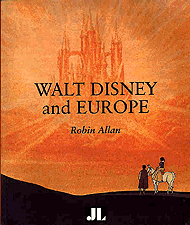Fred Patten reviews Robin Allan's new book, Walt Disney and Europe; European Influences on the Animated Feature Films of Walt Disney, and discovers that Allan delves far beyond the obvious nature of the title.

Walt Disney and his studio have been hailed since the 1930s as a master of American modern cinematic art and an influential molder of contemporarystandards of popular art, especially in the format of humorous cartooning. Allan's thesis is that "...the creative roots of the Disney empire...drew upon a European inheritance of literature, graphic and illustrative art, music and design as well as upon Europeanand indigenous cinema. I identify some of these sources which were utilized and transformed by Disney into a new art form." (pg.xv) Superficially, this concept is of "Well, duh!" obviousness. Everyone knows that Disney's cartoons, as well as those of everyother early animation studio, relied heavily on European folk tales,particularly from popularized juvenile collections of Aesop's Fables and the Grimm Brothers' fairy tales. Disney's first two animated features were adaptations of Snow White and the Seven Dwarfs and the Italian children's classic Pinocchio (while Disney's rival, the Fleischer Studios, countered with the British Gulliver's Travels). But Allan demonstrates in great detail that Disney's European influences were much more extensive and much more conscious than are generally realized. Starting with a broad survey of European influences on American late 19th and early 20th century popular culture (children'sliterature and toys, vaudeville and circuses, and anthropomorphized cartoons and fantasy art by such artists as Daumier and Doré), Allan cites Disney's own acknowledgments culled from his speechesand letters of his youthful favorite books, popular art and stage productions. Almost as soon as he began producing animated shorts in the 1920s, Disney studied the art in the highest quality illustratededitions of popular classic fairy tales, which at that time included paintings by such European artists as Arthur Rackham and GustafTenggren. Disney urged his animators to study these European artists. When the success of Mickey Mouse (1928) allowed Disney to beginhis creative expansion, a key new employee was the Swiss artist Albert Hurter, who became a major Disney art designer and mentorto the Disney staff from 1931 to his death in 1942. Allan reproduces numerous examples of European fantastic art from Hurter's personal library that he shared with the animation staff. In Summer 1935, Walt and his brother Roy and their families went on an extended European holiday. "While in Europe [Walt] had ordered a large quantity of books. ...the Disney Studio Library received a further consignment from 5 July to 24 September 1935 with 90 titles fromFrance, 81 from England, 149 from Germany..." (pg. 31) When Disney was ready to begin production on his ambitious features, he hired some of those European artists (such as Kay Nielsen, the Danish illustrator of the popular 1914 children's book East ofthe Sun and West of the Moon) to join his staff and help designSnow White, Pinocchio and Fantasia. Allan meticulously shows how Disney's features of the 1930s were influenced by medieval and 19th century Northern European artistic motifs. In the chapter on Pinocchio, "An important differencebetween the book and the film lies in its geographical location;the book is demonstrably Italian, both in locale and mood, redolent of sunshine and storm... The film is North European in look and specifically German in detailing." (pg. 78) Allan quotes discussions recorded at story conferences where Disney describes the artisticlook that he wants. There are comparative illustrations of street scenes in Pinocchio with almost-identical scenes in 18thand 19th century engravings of Germanic towns and photographs of streets in a well-preserved Bavarian medieval town. (Allan notes further that some of the reference art developed for but not used in the 1940 Pinocchio later showed up in the designs for the Disney theme parks.) Later chapters show how Disney and his staff evolved away from this Gothic look during the next decade, experimenting with contemporary European surrealistic art. During the 1950s, new notable artists joined the Disney staff including the American Eyvind Earle, who "used a number of Europe references [in the 1959 Sleeping Beauty]; Van Eyck, the Italian Primitives and their landscapes, Durer and Persian miniatures. He paid particularattention to the Duc de Berry's Tres Riches Heures..." (pg. 233) Disney's 1961 101 Dalmations was an artistic tribute by art director Ken Anderson to popular British mid-century cartoonists Ronald Searle and Rowland Emmett, who had both previously visited the Disney studio and formed friendships with several of the leadinganimators. The theme of Walt Disney and Europe may be obvious, but Allan fleshes it out in fascinating detail. Both the text and art emphasize primary sources, such as a reproduction of a page from the Disney Research Library's copy of Kenneth Grahame's The Reluctant Dragon showing Disney's personal penciled notations. There are 48 pages of beautifully reproduced color plates, and black-&-white illustrationson practically every page of text. The writing is clear and briskenough to satisfy general readers, and there are enough footnotes, appendices and bibliographies to please the most demanding academician. Most highly recommended! Walt Disney and Europe; European Influences on the Animated Feature Films of Walt Disney, by Robin Allan. Illustrated. London & Sydney, John Libbey & Company. Ltd., 1999. xvi + 304 pages. Trade paperback £22.50/$24.95, ISBN: 1-86462-041-2; hardcover £40.00/$49.95, ISBN: 1-86462-040-4. Fred Patten has written on anime for fan and professional magazinessince the late 1970s.







